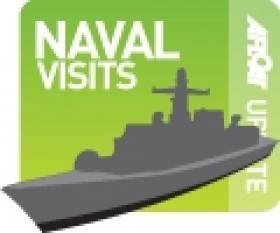Displaying items by tag: Landing Platform Dockship
#NavalVisits – One of the biggest Royal Netherlands Navy ships and a frigate is to visit Dublin Port, so to enable crew members time-off in addition to carrying out diplomatic and trade functions, writes Jehan Ashmore.
The Rotterdam-class HNLMS Johan de Witt, a Landing Platform Dock (LPD) amphibious warfare ship is of 16,500 displacement tonnes. The LPD ship is the second largest unit of the fleet and is named after a key figure in Dutch politics during the mid-17th century. This was a time when Dutch sea trade was notably flourishing and expanding on a world-wide stage that made the United Provinces a leading European power during the Dutch Golden Age.
As for the second naval visitor to the Irish capital, this will be a De Zeven Provinciën-class frigate HNLMS Evertson. The pair are to arrive tomorrow and remain in port over the weekend.
Afloat contacted the Dutch Embassy as to the purpose of the visit which said it would provide rest and recreation time for crew members. In addition to hosting on board receptions for members of the Diplomatic Corps as well as local Dutch businesses. The embassy added that unfortunately due to insufficient time, neither naval vessels will be open to the public.
The 166m HNLMS Johan de Witt can transport army troops along with associated vehicles and dispatch landing craft from the stern located landing well-dock. Above decks, helicopters can also be deployed from a hanger and use of two landing spots. In addition the LPD is equipped with a hospital featuring an operation theatre and intensive care facilities.
A sister of HNLMS Johan de Witt, the leadship of the namesake class HNLMS Rotterdam, have together previously paid a visit to Dublin. The leadship built by Damen Schelde Naval Shipyards was commissioned in 1998, whereas HNLMS Johann de Wit was constructed overseas in 2007 on the banks of the Danube in Galati, Romania. Another notable difference is that the leadship weighs in at a smaller 12,750 displacement tonnes.
Accompanying the LPD will be a De Zeven Provinciën-class frigate HNLMS Evertson of 6,050 displacement tonnes which was also completed by the same Dutch yard group. The 144m frigate has among armaments Goalkeeper guns and Sea Sparrow missiles. A helicopter can also be carried with flight crew joining a crew compliment of 174.
It is almost a year ago since a pair of these frigate class sisters paid a call to the capital following a major UK led naval exercise ‘Joint Warrior’ that involved other European navies.
As for the Dutch Navy, all of their ships have the prefix HNLMS (His Netherlands Majesty’s Ship) which are under the command of Commodore Ludger Brummelaar. On 1st January this year, he was appointed as the new Chief of the Military Household of His Majesty the King.
The Commodore is the first to be promoted to the rank of rear admiral and has succeeded Major General Hans van der Louw.
#LandingDockShip- HNLMS Johan de Witt (L801) an imposing yet impressive amphibious transport ship and HNLMS Amsterdam (A386) an auxiliary oil replenishment tanker of the Royal Netherlands Navy are to call to Dublin Port tomorrow, writes Jehan Ashmore.
HNLMS Johan de Witt is one of two such vessels also known as Landing Platform Docks (LPD) in the Dutch Navy and she is an enhanced verion of leadship class nameship HNLMS Rotterdam (L800) which has visited the capital before. The LPD half-sisters play an integral role in supporting ships in amphibious operations.
Earlier this month both the Dublin bound vessels formed part of a flotilla involved in exercises in the Irish Sea as they proceeded northbound.
HNLMS Johan de Witt is ten metres longer at 166m of 'Rotterdam' and can handle between 6-8 landing craft and is 16,500 tonnes. She will berth at Ocean Pier berth due to her 6m draft and likewise the 17,040dwt auxiliary oil replenishent (AOR) at sea vessel, HNLMS Amsterdam which has a larger draft of 8m. She is equipped with weapons systems and has a helideck and hanger for such aircraft.
The weapons systems of HNLMS Johan de Witt are .50 mm machine guns, 2 x Goalkeeper 30 mm and helicopters of 6 Lynx, NH-90, Chinook or Sea King helicopters. She can embark 600 units compared to her sister with that of 555 units.
The LPD can cater for either Landing Craft Vehicle and Personnel (LCVP) or Landing Craft Utility (LCU). In addition she can transport almost any type of vehicle. As well to carrying 32 Leopard 2 tanks and approximately 90 YPR armoured tracked vehicles and Patriot air-defence systems.
She is designed to be self-sufficient for at least a month and this involves supplies on board for a complete marine battalion and the ship's company. They are equipped with operating tables, intensive-care beds, treatment rooms and an emergency hospital for 100 patients.




























































